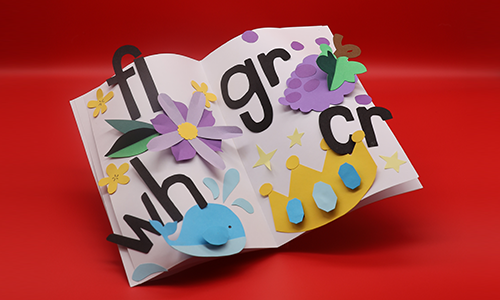
Yeah, yeah, we hear you, science of reading fans. You want to talk about phonics!
First off, let’s be clear that the science of reading is bigger than phonics. The science of reading is the converging evidence of what matters and what works in literacy instruction, organized around models that describe the how and why. Phonics is smaller in scope. It refers to how letter patterns represent sounds—and how we teach those patterns. Phonics is for supporting word decoding.
Phonics grabs a huge share of conversations about elementary literacy for good reason: critical to understanding the science of reading is understanding how good instruction in word decoding supports good reading outcomes in English.
What’s a “good reading outcome”? Ultimately, our goal is kids showing strong comprehension of challenging texts. Research addresses what kinds of skills matter for that outcome and what kinds of teaching work well for getting there. We’re not talking about one study, here; we’re talking about decades of accumulated and evolving insight from well-designed research.
A lot goes into teaching kids to read with comprehension. In this post, I’ll focus on one piece: word decoding (and, yes, that means we get to talk about phonics).
Decoding matters. Big time.
When researchers investigate what matters in literacy instruction, they look at how a component skill affects growth in the bigger domain of reading with comprehension. Particularly for elementary readers, improving word decoding gives kids a big boost in comprehension, in both the near and long term. That makes sense: if a student can’t read the words at all, then they sure can’t read them with understanding.
Great word decoding is necessary for reading with understanding, but it is not sufficient. Remember the Simple View of Reading?
 Once a student has strong word decoding skills, growth in reading comprehension becomes more dependent on language, including vocabulary and knowledge.
Once a student has strong word decoding skills, growth in reading comprehension becomes more dependent on language, including vocabulary and knowledge.
Early identification and intervention are critical
Because decoding matters big time, it is imperative that we support decoding for those who struggle through targeted early intervention. Intervention really works best if it is, well, targeted and early. That means we want to find the right kids, the ones likeliest to really need the intervention, and we want to do it before they are actually falling behind in reading.
Here’s where the science of reading gets almost magical. Research tells us that by assessing particular early skills—even before kids can read words—we can zero in on those students likely to struggle with decoding if we don’t intervene. Screening for signs of dyslexia and other decoding difficulties homes in on those early pre-reading skills that matter.
With this kind of screening, the two biggies are phonemic awareness and alphabet knowledge. Phonemic awareness is about noticing sounds within words; alphabet knowledge includes knowing what sounds letters stand for. These two foundational components come together as kids sound out words.
What works to launch decoding?
The science of reading clearly points to how teachers can best support the earliest stages of decoding. First, we know it works to systematically and explicitly teach kids to hear and work with the phonemes, or individual sounds, within words. We want them to hear the first phoneme in a short word like “dog.” Then we need to systematically move focus toward those final and middle sounds, too. Finally, we move on to working with words that have more sounds, like “blast.”
While many think of this instruction as being focused only on sound, research tells us that pairing sounds with visual letters in instruction is more effective. It helps kids to hear three phonemes in “cat” when they can connect those phonemes to letters. That’s phonics supporting phonemic awareness. Conversely, it helps kids understand how decoding works when we connect word families—“cat,” “bat,” “hat”—to the substituting of one first phoneme for another, orally. That’s phonemic awareness supporting phonics. Phonemic awareness and letter-sound understanding share the best kind of friendship, where just by being together they help each other grow.
Teaching of both phonemic awareness and phonics should be explicit: clearly demonstrate, then provide student practice and feedback, and then gradually support more independence in your students. Practice that looks like play keeps engagement high, which is critical to successful learning.
Sample exercises: Pair sounds to letters
How might a few minutes in a primary-grade classroom following the science of reading in decoding look? Here are a few examples:
- Two students can work together at a small whiteboard, with a bag of pictures or figures they can name using easy words: “cat,” “man,” “dog.” After one pulls out a picture or figure, they segment the sounds in the word aloud and draw a line for each phoneme. Next, they represent the spelling of each sound on each line, using either a set of magnetic alphabet tiles or a marker.
- In large groups, you can pull one common picture for all pairs to work on. This allows for formative assessment on the fly by letting you ask pairs to hold up their work before moving on to the next word.
- To extend the large-group activity, you can ask students to choose one letter in the word to replace with another. Kids then sound out their new “word.” Is it a real word, or just silly nonsense? Giggles are encouraged.
What works to further develop decoding?
After you’ve launched decoding and kids know and can use letter-sound correspondences in simple words, it’s time to really engage with the reality of English: a lot of our words are not that simple. Kids need to navigate a language where “dot,” “taut,” and “thought” all rhyme. This is where more advanced phonics and word study clearly support the improvement of students’ word reading. With practices like word study, phonics instruction goes well beyond the primary grades, moving to patterns and strategies for multisyllable word decoding.
Advanced phonics
Research has been clear since the National Reading Panel’s report two decades ago: teaching phonics systematicallyworks for improving reading comprehension long term.
“Systematic” means use of a planful sequence across and within skills. Yep, you need a phonics curriculum because your phonics instruction should not be just incidental or willy-nilly. When we teach systematically, we introduce the middle sound in “taut” after students know the /o/ sound in “dot.” While working on that AU spelling, we should provide practice reading and building AU words, practice with text reading that includes AU words, and practice in writing AU words.
Teaching whole-word memorization is not as effective. Instead, students should be shown how the sounds within words map back to the letters that make those sounds, and vice versa. When it is well developed, this ability to map back and forth between sounds and letters (a.k.a., orthographic mapping) turns out to be important for moving words into long-term memory.
While we ultimately aim for students to recognize words instantly, we can do more than just provide repeated exposure to those words. An instructional focus on the sounds and the spelling patterns within words is the fertilizer that helps a word grow automatic.
Word study
Words get harder as kids read richer text. Luckily, the science of reading continues to offer insight on what works as we support decoding multisyllable words.
Broadly, word study approaches are effective in improving decoding as readers move beyond simple words like “hat” to the more impenetrable, like “impenetrable.” This means teaching kids to examine new words through a syllable lens or a morpheme lens, or through a combination of both.
Syllable analysis involves identifying and dividing syllables within a word, using the understanding that each syllable has one vowel sound. Morpheme analysis involves finding prefixes, suffixes, root words, and inflectional endings; these are a word’s morphemes, or meaningful units.
Sample exercise: Word study with multisyllable words
How can the science of reading on decoding help an intermediate-grade classroom?
- Review several previously taught common prefixes (like dis-, in-, pre-, re-) and suffixes (like -ment, -tion, -ness, -able).
- To warm up, provide pairs of students with a list of multisyllable words in which to hunt for these prefixes and suffixes, word-search style, within a word list or passage.
- After students mark each prefix and suffix, have them practice reading the words aloud.
- Distribute some base words to each pair, asking students to create their own “big words” by adding a prefix and a suffix to each word. Share out and evaluate the results, considering the meaning of those morphemes. Have they constructed a real word or mumbo jumbo? Creativity and chuckles are both encouraged.
- To extend, include both morpheme and syllable analysis. After peeling off the prefix and suffix in a word in challenging text, analyze the syllables in the remaining base word. How many vowel sounds are there and, therefore, how many syllables? How is each syllable pronounced?
What’s next?
I encourage you to dig in further on support for word decoding in one or all of the following ways.
I linked to several research articles foundational to this post in the text above, for you to pop open and consider. If some of those are too theoretical, too statistical, or otherwise too snooze-inducing for you, focus on the highly useful foundational skills research-to-practice guide offered through What Works Clearinghouse. It connects strong research evidence to strong practices in phonemic awareness and a broad scope of phonics. This and other practice guides were produced through a longstanding effort by the U.S. Department of Education to support—you guessed it—the science of reading. Finally, I encourage you to read and download our eBook Everything you need to know about the science of reading.
Whatever further reading you decide to do, why not use what you learn to build your own local Team Science of Reading? Together with colleagues, discuss what you read, try ideas out, and then come back together to share and reflect.




